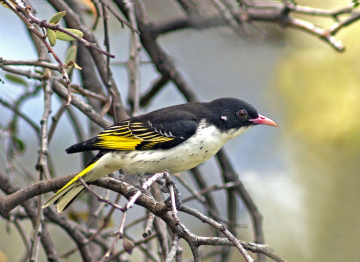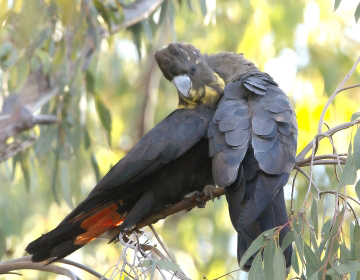Wildlife

Potential to conserve wildlife
Brigalow vegetation in Queensland supports many different types of native plants and animals, including at least 32 threatened or priority species.
The region occupied by brigalow is significant for native land snails, containing at least 132 species, including 79 species that are unique to that region.
At least 23 native species of land snail have been collected from brigalow vegetation. Sixteen of Queensland’s regional ecosystems, where brigalow is a dominant or co-dominant tree, have also been listed as an endangered ecological community under the Environment Protection and Biodiversity Conservation Act 1999 because their area has been reduced by clearing.

Limits to wildlife conservation
Most actions that will accumulate carbon in cleared brigalow country (such as not clearing regenerating trees, preventing hot fires, and reducing grazing pressure) also benefit wildlife by reducing threats.
Different types of shelter for wildlife, a good (and varied) supply of food, the removal or control of weeds and feral animals, and the size and shape of habitat patches and their distance from each other, will help conserve wildlife in brigalow country.

Habitat for wildlife
| Feature | Benefits for wildlife | Used by |
|---|---|---|
| Trees and shrubs |
Nesting, shelter and feeding sites
A diversity of tree and shrub species that flower and fruit at different times can provide a continuous food supply (nectar, pollen, fruit and insects) for animals Dense understorey shrubs can discourage aggressive noisy miners and yellow-throated miners, which may exclude small birds Some animal species need trees and shrubs of a certain size or age (e.g. saplings or dead, standing trees) | Birds, invertebrates, mammals, reptiles, frogs, parasitic plants (e.g. mistletoe) |
| Tree hollows, cracks and crevices | Shelter, nesting, a place to find food | Parrots, treecreepers, bats, gliders, reptiles |
| Fallen timber | Shelter, basking and feeding areas | Birds, reptiles, frogs, mammals, invertebrates |
| Mistletoe |
Nectar, berries and nesting sites
Can provide nectar and berries at times when these foods are scarce in the landscape | Birds, invertebrates, mammals |
| Leaf litter | Shelter and feeding areas | Birds, invertebrates, reptiles, frogs, mammals |
| Rocks | Shelter, basking and feedings areas; habitat for plants | Invertebrates, reptiles, frogs, mammals, plants |
| Gilgais | Habitat for plants; shelter and feeding areas | Plants, frogs, birds, invertebrates |
| Invertebrates | Food, pollination, seed dispersal | Birds, reptiles, frogs, mammals, plants |
| Fungi | Food, beneficial relationship with plants | Mammals, invertebrates |
| Feature | Benefits for wildlife |
|---|---|
| Large patch size |
Support larger populations of plants and animals
Support animals that need large territories and/or occur in low population densities May also support more species of wildlife |
| Small edge-to-area ratio |
Patches that are rounded in shape suffer fewer ‘edge effects’ than patches of a similar size that are long and thin
Edge effects include increased weed invasion, predation, wind, sun and temperature, and all of these can have important impacts on wildlife |
| Close to other patches |
Allows animals and plants to disperse between patches
Reduces the risk of predation for animals when they move between patches Improves the exchange of pollen between patches |
| How much of the landscape is cleared |
Birds and mammals are negatively affected if more than 70% of the landscape is cleared of suitable habitat
There is also an interaction between grazing and how much of the landscape is cleared, as cattle tend to congregate in the remaining patches of woody vegetation If most of a landscape, or vegetation type, has been cleared, this also means that any remnants are very important for wildlife conservation, even if they are small or in poor condition. These remnants may provide valuable source populations for restoring other parts of the landscape |
| Tree hollows, cracks & crevices | Fallen timber | Trees & shrubs | Gilgais | Litter | Mistletoe | Rocks | Insects | |
|---|---|---|---|---|---|---|---|---|
| Mammals | ||||||||
| Little pied bat | x | x | x | |||||
| Sugar glider | x | x | x | |||||
| Bridled nailtail wallaby | x | x | ||||||
| Birds | ||||||||
| Painted honeyeater | x | x | x | |||||
| Glossy black-cockatoo (eastern) | x | x | ||||||
| White-throated treecreeper | x | x | x | |||||
| Rufous whistler | x | x | ||||||
| Grey fantail | x | x | x | |||||
| Reptiles | ||||||||
| Short-necked worm-skink | x | x | x | |||||
| Common death adder | x | |||||||
| Ornamental snake | x | x | ||||||
| Yakka skink | x | x | ||||||
| Dunmall’s snake | x | x | ||||||
| Brigalow scaly-foot | x | x | ||||||
| Golden-tailed gecko | x | x | x | |||||
| Frogs | x | x | x | x | x | |||
| Insects | x | x | x | x | x | x | x | x |
| Pale imperial hairstreak butterfly | x | x | ||||||
| Brown awl butterfly | x | |||||||
| x | x | x | x | |||||
| Plants | x | x | x | x |
Threats to wildlife
| Threat | Impacts on wildlife | Wildlife affected |
|---|---|---|
| Weeds and feral animals |
Competition, predation
Some management actions to control weeds and feral animals can also have negative impacts on native species | Many different types of plants and animals |
| Exotic grasses |
Replacement of native plant species
Changes in habitat structure Increased intensity and frequency of fire | Plants, birds, reptiles, mammals |
| Noisy miners and yellow-throated miners | These are aggressive native bird species that reduce the abundance and species richness of small woodland birds | Small birds |
| Stem density |
Can slow the development of large trees, hollows and the accumulation of fallen timber
But can also provide habitat for some small birds and help to exclude aggressive noisy miners and yellow-throated miners | Many different types of animals |
| Grazing pressure | Can reduce shelter and food for wildlife by slowing and preventing the recruitment and growth of brigalow, grasses and understorey shrubs, and by trampling and reducing the amount of litter and fallen timber | Many different types of plants and animals |
| Clearing |
Removes many plant and animal species
Removes food and shelter for animals that depend on the plant species and structure found in mature brigalow | Many different types of plants and animals |
| Fire |
Many brigalow plant species have limited capacity to resprout after hot fires
Fire destroys features such as litter, fallen timber and hollows which are important for many animal species Fire is a major threat to the many species of land snails that are associated with brigalow Even low severity management fires can remove habitat such as large hollow-bearing trees, which provide essential resources for many fauna | Many different types of plants and animals |